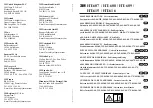
RIDING INSTRUCTIONS 8
29
The cold start button goes to the basic position.
–
After reaching maximum speed by fully opening the throttle grip,
turn the throttle back so it is ¾ open. This will barely reduce the
speed, but fuel consumption will be considerably lower.
–
Only open the throttle as much as the engine can handle
–
abrupt
throttle grip opening increases fuel consumption.
–
To shift down, apply the brakes and close the throttle at the same
time.
–
Pull the clutch lever and shift into a lower gear, release the clutch
lever slowly, and either open the throttle or shift again.
–
Switch off the engine if you are likely to be running at idle speed or
stationary for a long time.
Guideline
≥
1 min
–
Avoid frequent or lengthy slipping of the clutch. This causes the
engine oil, engine and cooling system to heat up.
–
Ride at a low engine speed instead of at a high engine speed with a
slipping clutch.
F03642-10
Condition
Quickshifter activated.
–
If the quickshifter is activated, you can shift up in the engine
speed range shown without pulling the clutch lever.
Info
The quickshifter is not activated when shifting up from
first to second gear, and the clutch lever must be used
when shifting up instead.
The minimum engine speed before shifting up is shown
in the figure in revolutions per minute.
Pull the shift lever to the stop quickly without changing
the throttle twist grip position.
Even if the quickshifter is activated, you need to use the
clutch lever to shift down.
If the shifting performance of the quickshifter starts to
decrease, it must be reprogrammed.
8.10
Applying the brakes
Warning
Danger of accidents
Excessively forceful application of the brakes blocks the wheels.
–
Adjust application of the brakes to the respective riding situation and riding surface conditions.
Warning
Danger of accidents
A spongy pressure point on the front or rear brake reduces braking efficiency.
–
Check the brake system and do not continue riding until the problem is eliminated. (Your authorized GAS-
GAS Motorcycles workshop will be glad to help.)
Warning
Danger of accidents
Moisture and dirt impair the brake system.
–
Brake carefully several times to dry out and remove dirt from the brake linings and the brake discs.
–
On sandy, wet, or slippery surfaces, use mostly the rear brake.
–
Always finish braking before you go into a bend. Shift down to a lower gear appropriate to your speed.
















































